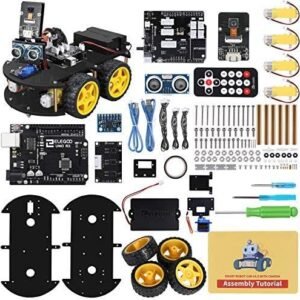Title:
As we stand on the brink of a transportation revolution, the role of artificial intelligence (AI) in shaping the future of autonomous vehicles cannot be overstated. Picture this: a world where cars navigate bustling city streets, negotiate complex intersections, and respond to dynamic driving conditions—all without human intervention. It’s a transformative vision made possible by advanced algorithms and machine learning techniques that enable vehicles to make split-second decisions with unparalleled precision. In this article, we will explore the myriad ways in which AI is driving innovation in the automotive industry, examining how it enhances safety, improves efficiency, and paves the way for a more sustainable future. Join us as we delve into the cutting-edge technologies that are not just changing how we think about transportation, but are actively redefining our relationship with mobility.
Table of Contents
- Understanding the Role of Machine Learning in Autonomous Vehicle Navigation
- Enhancing Safety Features with AI-Driven Predictive Analytics
- The Importance of Data Collection and Real-Time Processing in Autonomous Systems
- Future Innovations: How AI Will Shape the Next Generation of Autonomous Driving Technologies
- Final Thoughts
Understanding the Role of Machine Learning in Autonomous Vehicle Navigation
At the heart of autonomous vehicle technology lies machine learning, a powerful subset of artificial intelligence that enables vehicles to interpret and respond to their environments. By analyzing vast amounts of data collected from various sensors—such as LiDAR, cameras, and radar—machine learning algorithms detect and classify objects, recognize patterns, and make real-time decisions. Key components of machine learning in this context include:
- Perception: Understanding surroundings through object detection and classification.
- Localization: Determining the precise position of the vehicle in relation to its environment.
- Path planning: Calculating the most efficient route while avoiding obstacles.
This technology operates within a feedback loop, continuously learning from every mile driven. As autonomous vehicles gather more data during trips, they refine their algorithms to improve accuracy and safety. Additionally, machine learning facilitates predictive modeling that allows cars to foresee and adapt to potential hazards, enhancing the overall driving experience. The integration of neural networks further advances this technology, offering adaptable solutions to complex scenarios. Below is a brief overview of the pertinent machine learning techniques influencing autonomous vehicles:
| Technique | Description | Role in Navigation |
|---|---|---|
| Supervised Learning | Models trained on labeled datasets | Object recognition and classification |
| Unsupervised Learning | Models identify patterns without labeled data | Clustering similar driving scenarios |
| Reinforcement Learning | Agents learn by receiving rewards or penalties | Improving decision making in dynamic environments |
Enhancing Safety Features with AI-Driven Predictive Analytics
Artificial Intelligence is revolutionizing the way we ensure safety in autonomous vehicles by leveraging predictive analytics to foresee potential hazards before they escalate. By analyzing real-time data from various sensors and surrounding environmental conditions, AI models can identify patterns that human drivers may overlook. This proactive approach enables vehicles to take preventative measures, such as adjusting speed or altering course, thereby significantly reducing the risk of accidents. Key benefits include:
- Real-time risk assessment: Continuous evaluation of driver behaviors and environmental factors.
- Dynamic response adaptation: Instantaneous adjustments to driving strategies based on predictive outcomes.
- Enhanced decision-making: Improved accuracy in identifying potential threats, which aids in quick reaction times.
Furthermore, as AI-driven predictive analytics evolves, its ability to integrate with vehicle-to-everything (V2X) communication systems enhances safety even further. This interconnectedness allows cars to exchange critical information with their surroundings—other vehicles, infrastructure, and pedestrians. The data collected can be used to create comprehensive safety profiles to forecast and prevent accidents effectively. A concise breakdown of various AI applications in enhancing safety features includes:
| Application | Description |
|---|---|
| Obstacle Detection | Real-time identification of objects in the vehicle’s path. |
| Traffic Pattern Analysis | AI predicts high-traffic scenarios, allowing for route adjustments. |
| Driver Behavior Monitoring | Tracking and analyzing driver alertness for better safety interventions. |
The Importance of Data Collection and Real-Time Processing in Autonomous Systems
The backbone of autonomous vehicles lies in their ability to collect and process data in real time. By leveraging a multitude of sensors, including cameras, radar, and LiDAR, these systems gather vast amounts of information about their surroundings. This data collection enables vehicles to make informed decisions almost instantaneously. For instance, when a pedestrian suddenly steps into the road, the vehicle must swiftly analyze the situation, processing data about distance, speed, and potential routes to ensure safety. The importance of this rapid processing cannot be overstated; it shapes the very efficacy and reliability of autonomous driving technology.
Furthermore, integrating advanced algorithms, machine learning, and artificial intelligence enhances the decision-making process through pattern recognition. By utilizing a layered approach to real-time data processing, autonomous vehicles can identify recurring traffic patterns, predict possible road hazards, and adapt to changing environments efficiently. This synergy of data collection and processing creates a continuously evolving learning system that improves over time. Some key benefits include:
- Increased Safety: Immediate response to hazards enhances overall road safety.
- Optimal Route Planning: Ability to avoid congested areas and enhance travel efficiency.
- Adaptive Learning: Continuous improvement of driving algorithms through data feedback.
Future Innovations: How AI Will Shape the Next Generation of Autonomous Driving Technologies
As we venture into a future powered by artificial intelligence, the landscape of autonomous driving technologies promises to undergo a transformative shift. AI algorithms are set to enhance the decision-making processes of vehicles, enabling them to navigate complex environments with ease. This includes innovations such as:
- Adaptive Learning: Vehicles will continuously learn from their surroundings, adapting their behaviors based on real-time data.
- Predictive Analytics: AI will anticipate potential hazards and traffic patterns, improving safety and efficiency.
- V2X Communication: Vehicles will communicate with each other and with infrastructure, optimizing routes and reducing congestion.
Furthermore, AI will play a crucial role in enhancing the user experience through personalization. As vehicles collect and analyze data about driver preferences, the cabin environment can be adjusted to cater to individual needs. A potential future scenario could involve:
| Feature | Description |
|---|---|
| Customizable Interface | Personalized dashboards that align with user preferences. |
| Adaptive Sound Systems | Audio settings that adjust based on driving conditions and mood. |
| Onboard Concierge | AI-driven assistance offering recommendations and managing tasks. |
Final Thoughts
As we stand on the brink of a new era in transportation, the role of artificial intelligence in shaping the future of autonomous vehicles cannot be overstated. From enhancing safety features to optimizing traffic management and improving user experience, AI is the backbone that supports the seamless integration of self-driving technology into our daily lives.
The developments we’ve explored highlight not only the technological advancements but also the ethical and regulatory challenges that accompany this innovation. As research and development continue to push boundaries, collaboration among technologists, policymakers, and consumers will be crucial to navigate the complex landscape of autonomous driving.
As we move forward, it’s clear that the journey toward fully autonomous vehicles will be paved by ongoing advancements in AI. The promise of safer, more efficient, and sustainable transportation is within reach. So, whether you’re an enthusiast eagerly awaiting the next breakthrough or a cautious observer pondering the implications, one thing is certain: AI is driving us into a new chapter of mobility that will redefine the way we think about travel.
Stay tuned for updates on this exciting field, and join us as we watch the remarkable evolution of autonomous vehicles unfold. The road ahead is not just about technology; it is about the future of how we connect, commute, and coexist.





